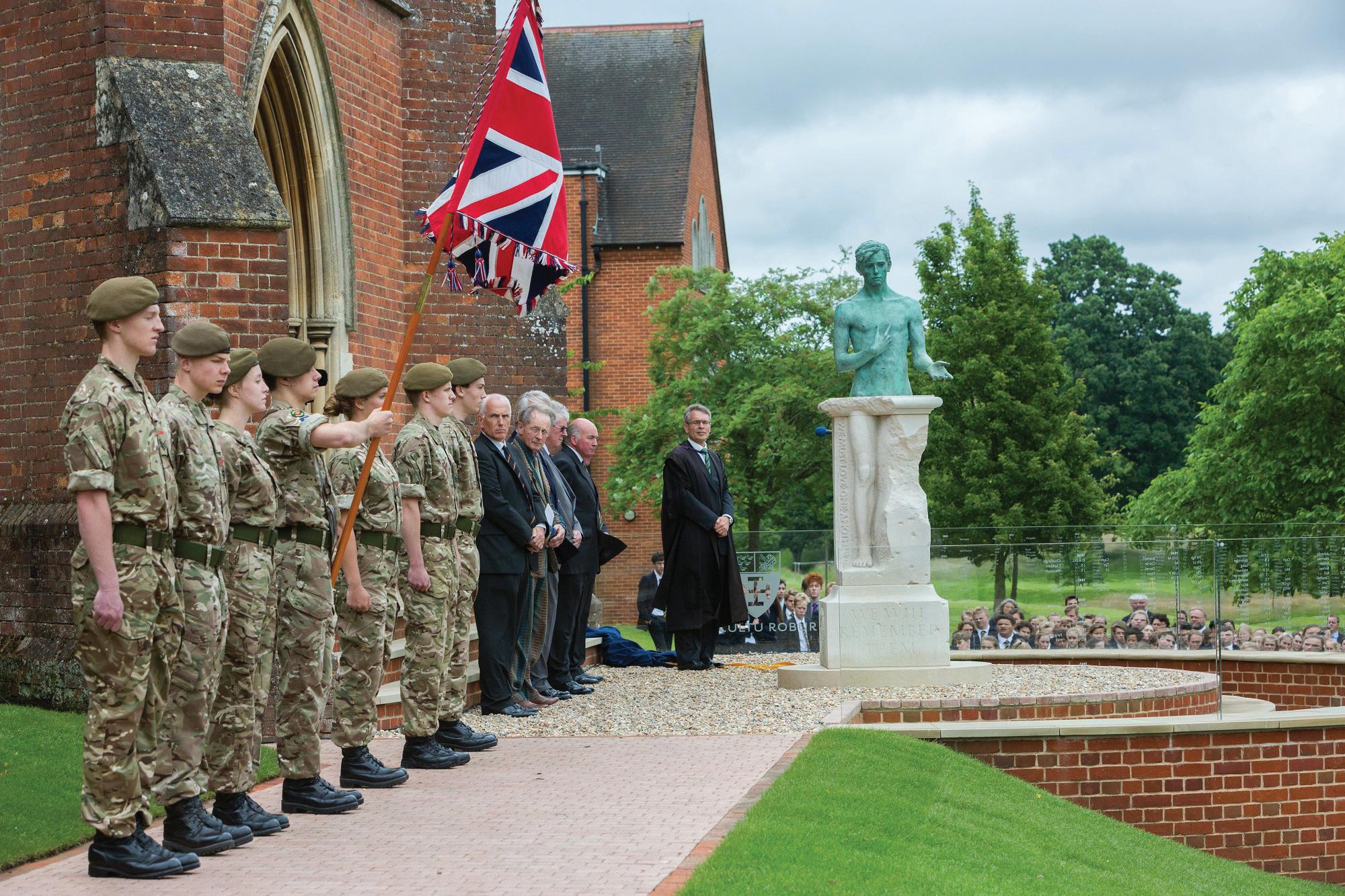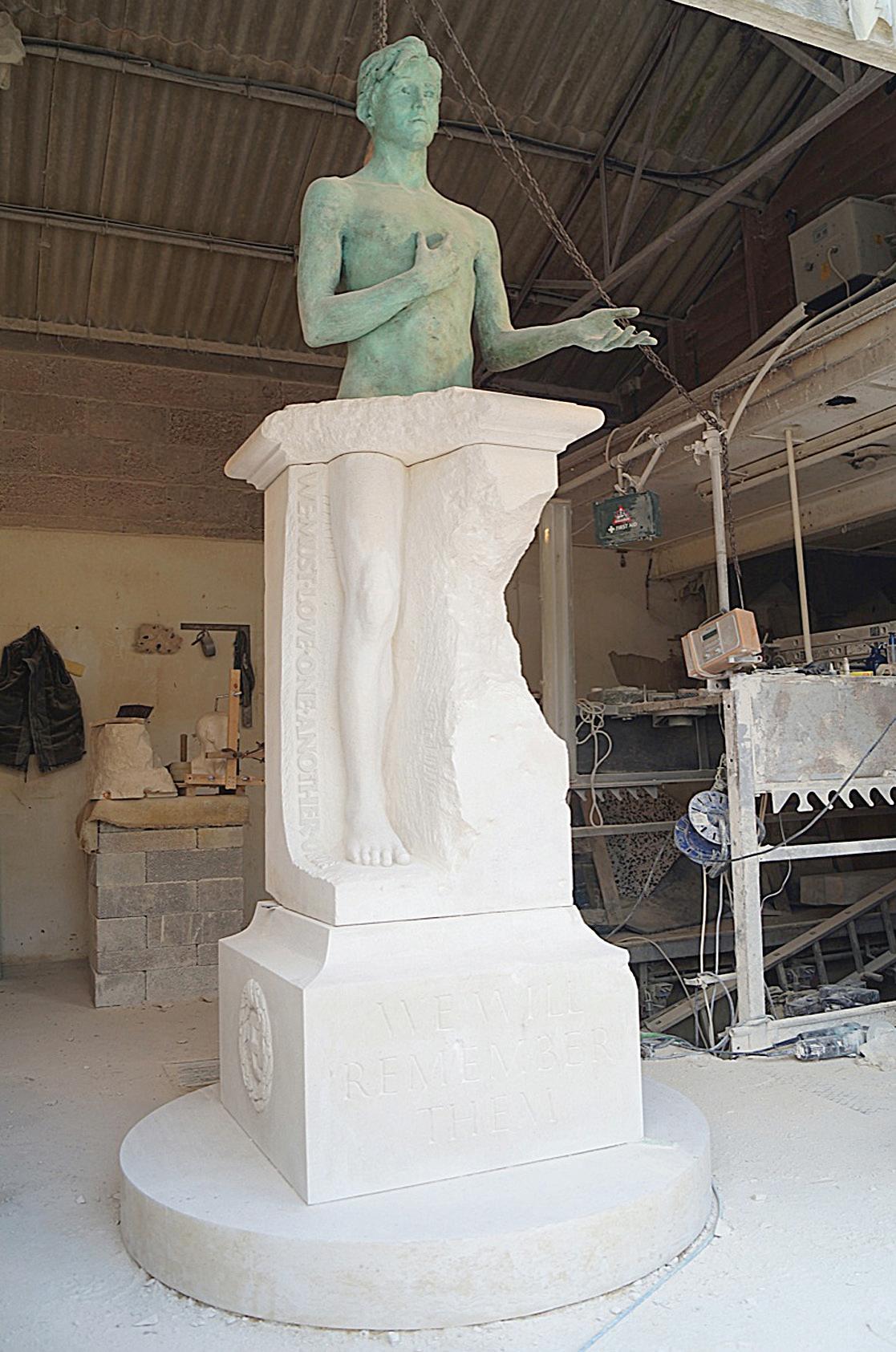
5 minute read
A War Memorial for a modern school
‘War is strange. Death, destruction, cruelty, confusion, loss of familiar signposts are all its elements. Yet, it does, too, conjure other things to be remembered – comradeship, the fellowship of a tank crew, loyalty, small incidents which renew one’s faith in humanity. Those elements are collectively called peace.’
Words of former Cranleigh Headmaster Marc van Hasselt (1970-1984), one of the few surviving D-Day veterans, who recently received the Légion d’Honneur from the French government for his part in the landings. A poignant new War Memorial by leading British sculptor Nicholas Dimbleby was unveiled at Cranleigh School on 1st July 2016, exactly 100 years after the devastation of the Battle of the Somme. At the heart of the Memorial is a threemetre high sculpture, in bronze and Bath stone, depicting a naked boy attempting to stride ahead into his future, but who finds himself restrained by what appears to be the ruin of a conventional stone Memorial, ravaged by further war.
Entitled Leaving, the dramatic sculpture is sited in an elevated position looking out across the Surrey Hills and surrounded by sweeping glass panels engraved with the names of 374 former pupils who have fallen in battle during the School’s 150-year history.
Old Cranleighan Nicholas Dimbleby’s sculpture Leaving
Memorial unveiling.
For the School, which opened its doors to the first pupils in 1865, commissioning a new war memorial has been a challenging and at times emotional process. From the outset there was a wish to create something that would commemorate history and the service of the fallen, whilst simultaneously making the memorial relevant to a generation of pupils that thinks in terms of globalisation and peacekeeping. Current international events and the anniversary of key World War One dates combined to make the process especially thoughtprovoking.
It was always the school’s intention to work with an artist to create such a modern memorial. Luckily Cranleigh can count one of the country’s foremost figurative sculptors among its alumni. Nicholas Dimbleby (1 North, 1964), the creator of the well-known Whistler on the Southbank, was happily free to undertake the commission. He launched into research with infectious energy, convening meetings with pupils as well as senior staff and Old Cranleighans to get to the heart of the


www.pilotconsulting.co.uk
Nick Dimbleby and Memorial.


design. He has described the experience as being “what my whole career has led to”.
“This has been profoundly moving. There is a burden of responsibility with a War Memorial that perhaps weighs more heavily than with previous work. My client for this commission has been the children, in particular those of school leaving age, whose predecessors 100 years ago walked straight into war.
“Through conversations with these young people it became apparent that the desire for peace greatly outweighs the ‘nobility of death in battle’ and that therefore this should not be a ‘generic’ memorial, simply a listing of the fallen.
This age is much more sceptical. Alongside leaving and service to the outside world, the sculptural element of this memorial is intended to convey vulnerability and the devastation of war. It is entirely right that the figure should be an unclothed youth. It shows us in our most vulnerable state of being.”
Nicholas Dimbleby, whose next commissions are a sculpture of S T Coleridge and a bronze for Guy’s Hospital, is now based in Somerset, but still uses a foundry at Leatherhead, near the School, to cast his works.
“That this was in a school helped to focus my mind and made the concept in some ways less constrained. I had an age group in mind and the freedom of working on a ‘private’ campus. It was a great help that I knew Cranleigh. The rapport has been excellent and I have felt a reward in working together on such an ambitious project for my old school. As with any establishment that gives the sculptor freedom to work in an atmosphere of trust it has been liberating to work for.”
Engraved in the stone are the conventional words of commemoration ‘We will remember them’, seemingly damaged by gunfire to represent the destruction caused by World War Two, together with W H Auden’s foreboding ‘We must love one another or die.’
“We failed to learn from our first experience,” says Dimbleby, “and we did it all again.”
The School’s original memorial to those who fell in the Great War was designed by Sir Edwin Cooper, the architect of two major buildings on campus, and unveiled in 1921. It was removed for reasons unknown in 1952 and a replacement has been long awaited, particularly by the School’s active alumni association, The Old Cranleighan Society.
Martin Williamson, the Society’s chairman, said: “We are lucky to have such a renowned sculptor as an old boy because we wanted something that came from Cranleigh’s heart and to ensure that the person responsible understood what the School was about, as we are not a military school.
“It was immediately clear that Nick had a very different idea of what a Memorial should be, but his passion and vision won us over and the end result is quite stunning. He also made us realise that the memorial could be an actively used area and not an inaccessible sanctuary. The end result is something that breaks with tradition and will, I believe, inspire much thought about the way memorials are designed.”
Cranleigh’s Headmaster, Martin Reader, commented: “Historically, public schools including Cranleigh have played an important role in preparing boys to become officers in the British Army, and as such we have witnessed the loss of many of our young men in conflict. In our 150th year, and coinciding with the centenary of one of the bloodiest battles of World War One, it is entirely fitting that Nicholas Dimbleby has created a new Memorial for the School, a Memorial that remembers our fallen, but also, importantly, strives for peace, encouraging our young people to lead fulfilled lives in service and duty as well as leadership in their futures.”
The memorial was unveiled in a special service to remember the fallen, which was led by the former Chief of the General Staff, Lord Dannatt.










